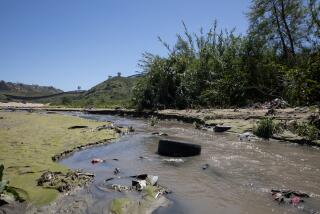U.S. and State Sue City Over Sewage
The federal and state governments teamed up Wednesday to file a lawsuit against the City of San Diego for discharging raw and inadequately treated sewage into the ocean and local waterways since 1983.
The civil action was filed by the U. S. attorney’s office in San Diego federal court on behalf of the federal Environmental Protection Agency and the state Regional Water Quality Control Board. It accuses the city of ignoring a July 1 deadline set by the federal Clean Water Act to provide secondary sewage treatment, which would remove 90% of the solid wastes before the sewage is dumped into the ocean. The city now relies on an advanced primary-treatment process at its Point Loma treatment plant, which removes 75% of the solid wastes from sewage.
The suit also recites a litany of San Diego sewage abuses, alleging that raw sewage has spilled into the ocean and local waterways from defective sewer lines and failed pump stations 1,814 times over the past five years.
Dumping of Sludge at Brown Field, Mission Bay
The complaint also contends that the city violated its discharge permit through the unauthorized dumping of sludge, the gooey byproduct of sewage treatment, at an abandoned Brown Field treatment plant at least 92 times from January, 1984, to February, 1986. On four occasions, from December, 1983, to October, 1986, the gooey sludge also was discharged directly into Mission Bay, the suit says.
The suit seeks civil fines against the city ranging from $10,000 to $25,000 a day for each violation. The higher amount is sought for every day from Feb. 4, 1987, to the present.
The suit also asks the federal court to force the city to build a secondary sewage treatment plant and repair its existing facilities.
Yvonne Rehg, a spokeswoman for the San Diego water department, acknowledged Wednesday that there have been major problems with sewage spills from the aging waste-water system, most notably in the beach areas and at Pump Station 64 near Los Penasquitos Lagoon.
But, she said, the city has spent a lot of money to remedy the problems.
For instance, the city--under threat of action by the state--invested $23 million to overhaul Pump Station 64, Rehg said, and has embarked on an ambitious $93-million campaign to repair, replace and improve maintenance of 37 miles of underground sewer pipes.
However, those sums pale before the $1.5 billion to $2.4 billion city officials now say it will take to build a secondary sewage treatment plant to satisfy EPA requirements. At that cost, the plant would be the largest public works project ever undertaken by the city.
City officials have long resisted the federal mandate under the Clean Water Act to build such a plant, arguing that primary-treated sewage poses no harm to the ocean environment. In 1981, city officials obtained a temporary waiver from the mandate and abandoned plans to build the plant.
But that decision came back to haunt the city in 1987, when EPA officials refused to extend the exemption. By that time, most of the federal funds to pay for secondary sewage plants had vanished and San Diego officials faced the unpleasant prospect of financing the project by quadrupling, to $40, monthly sewage bills.
Earlier this year, city officials began negotiating with the EPA, hoping to sign a consent decree that would commit the federal government to kicking in a substantial amount of money for the secondary sewage treatment plant. When both sides refused to budge on the questions of funding and a starting date for the project, negotiations broke down and the federal government prepared the lawsuit that was filed Wednesday.
On the same day it filed the lawsuit against San Diego, the EPA released a report that said 87% of the nation’s major sewage treatment plants comply with the secondary treatment requirements. Lee M. Thomas, EPA administrator, called the compliance a “success story of which state and federal environmental officials can truly be proud,” adding that more than $60 billion in federal and state funds have been spent to improve the facilities across the country.
Contributing to this report was Times Staff Writer David Savage in Washington.
More to Read
Sign up for Essential California
The most important California stories and recommendations in your inbox every morning.
You may occasionally receive promotional content from the Los Angeles Times.










